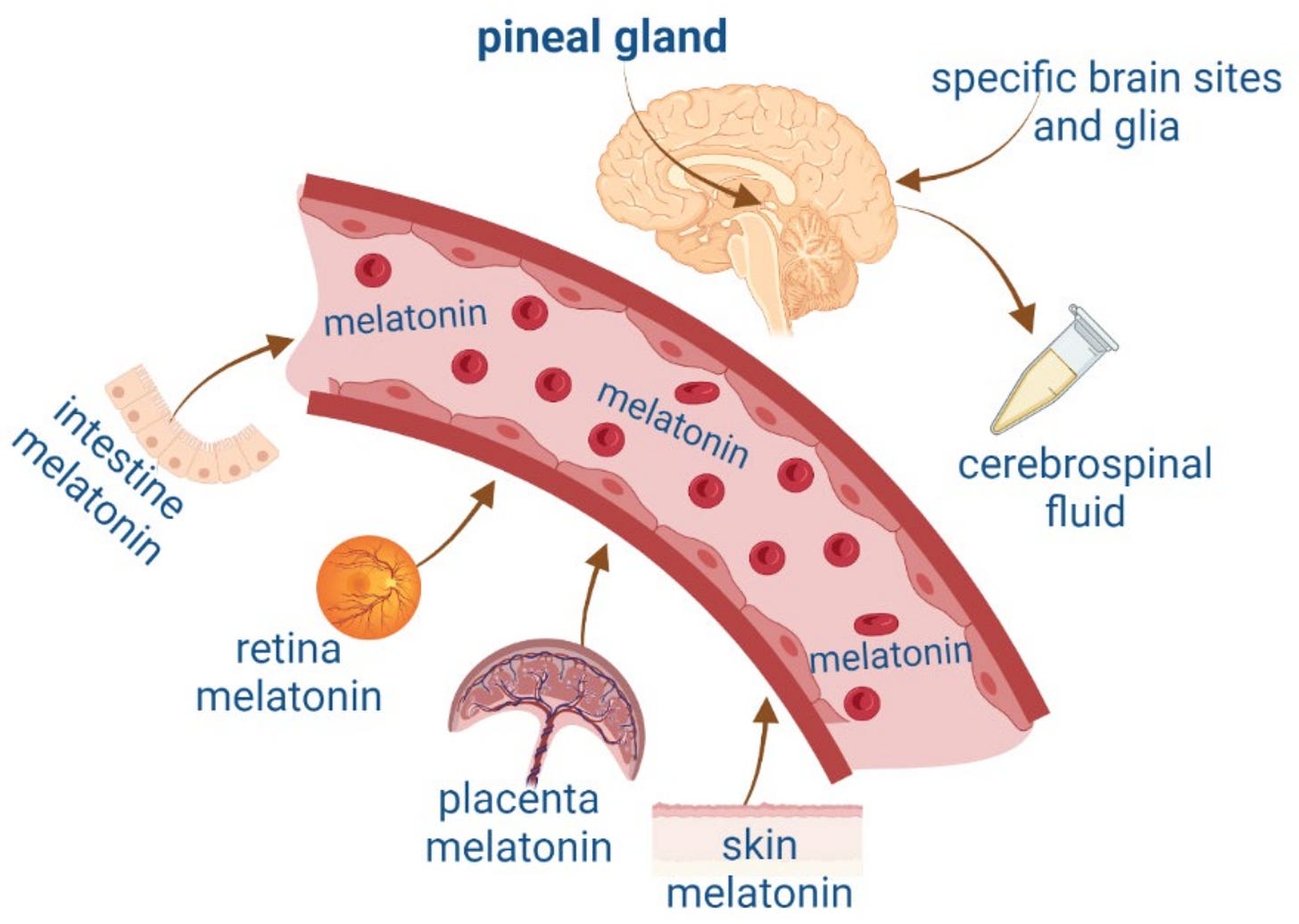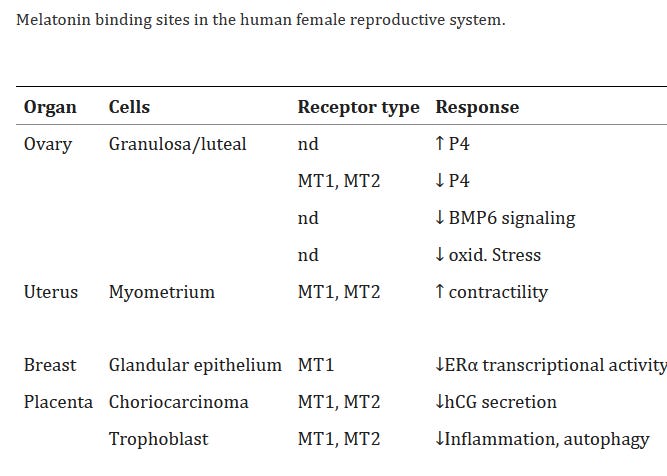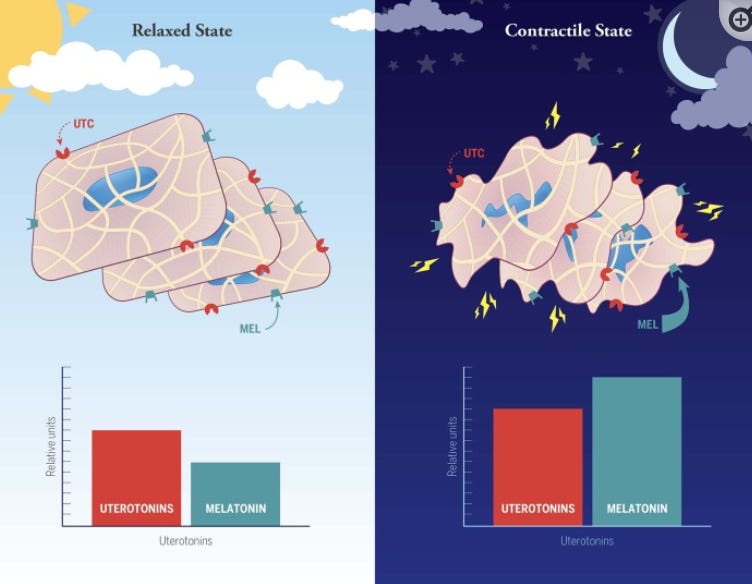Could smartphones cause early puberty?
Our children's blue light pandemic | Impacts on fertility | Melatonin as a master hormone
Here’s what we’ll learn in this article:
1. Why did the pandemic cause early puberty in girls?
2. How does our skin sense and absorb blue light?
3. Why melatonin is our master hormone
4. How do melatonin levels affect fertility?
5. What is the fertility clock?
6. Why are most babies born in the middle of the night?
7. How do our homes make us blue light-toxic?
8. How does blue light cause rapid aging?
9. How does blue light affect puberty?
10. Basic ancestral solutions to a complex modern problem
“If in your fear you would seek only love’s peace and love’s pleasure,
Then it is better for you that you cover your nakedness
and pass out of love’s threshing-floor,
Into the seasonless world where you
shall laugh, but not all of your laughter,
and weep, but not all of your tears.”
-Kahlil Gibran, The Prophet
The pandemic began on a screen, and continues to play out on a screen.
The only ones not playing are the children, who are quickly turning into adults.
Many studies conducted in the early years of the pandemic attempted to link early puberty with a virus.1

What if the real reason was the blue-light virus in our software, affecting our body’s hardware?
When I was a child, I couldn’t wait to go play in the dirt, smash sticks against rocks, or just gaze endlessly into the babbling brook.
There are three things that most of us can’t stop watching:
Fire, water, and people working.
Why? All living things are drawn to fields of energy.
This is why so many of us love to see a good Sunrise or Sunset - as the force of the Sun acts upon our primal craving to experience energy in its raw element.
Today many of us are subconsciously drawn to a different type of screen, like the one you’re using right now to read my words.
Now close your eyes - just for a second.
What did you see?
Darkness. Yet the rest of your body saw a different picture.
Our skin is still perceiving and absorbing the blue light coming off the screen.
How does this happen?
It turns out our skin has eyes like a peacock, that are embedded in our subcutaneous fat. Those “eyes” are a protein called melanopsin.
Melanopsin is very sensitive to blue light, and is contained in fat cells called white adipocytes.2

Why is this important?
Melanopsin regulates the amount of melatonin our bodies can use, and melatonin drives hormonal production in the rest of our body. While we may think of melatonin as the sleep hormone, it is really so much more. Hormones tell our bodies when to eat, sleep, breathe, and reproduce. Melatonin alone synchronizes the biological functions of our pancreas, liver, kidney, adrenal gland, heart, digestive tract, lungs, and reproductive organs.
Believe it or not, we have at least 400 times more melatonin3 in the gastrointestinal (GI) tract than we do in our pineal gland! This is why all digestion begins in the skin and the eye, before it can precipitate to our GI.
The female reproductive system has even more binding sites for melatonin:
How do melatonin levels affect fertility?
Mammals are geared to reproduce in the warmer months.
Ever see a deer have sex on the snowy beach? I didn’t think so.
Pass that margarita dear…and let me tell you why.
Aside from the warmth that we, and those horny friends of ours love, there is another reason we often miss while basking in our heat of solar passion. There is more light in our environment during spring and summer, and this light reduces the amount of melatonin we have. The melatonin that we’ve stored in the darker months is then absorbed and used by many of our reproductive organs.4 This is why melatonin levels are typically highest in the winter, and lower in summer.
How does melatonin affect birth?
Melatonin is also the reason why babies are typically born at night, as this hormone helps the uterus contract:
What happens when we live indoors most of the year?
We enter a season-less world, where we pass through life living a stone-cold summer that freezes the blooms of our vitality, and steals the fruits of all humanity’s labor.
Our windows not only block most of the healing wavelengths of Sunlight like infrared and UV, they also keep in artificial light from our screens, rendering us blue-light toxic.
Blue light destroys our body’s ability to make critical pro-growth hormones5 like melatonin, testosterone, and estrogen, as hormonal production is switched to cortisol, which can potentially lead to chronic stress.
The cascade of inflammation begins when blue light hits the melanopsin photoreceptors in our skin6 and eye, as retinol.7 Also known as Vitamin A, retinol has a very loose chemical bond with melanopsin. When this bond is broken, chaos ensues for our hormones.
“Although not conclusive, we advise that use of blue light emitting devices should be minimised in pre-pubertal children, especially in the evening when exposure may have the most hormone-altering effects.”
- Dr. Aylin Kilinç Uğurlu, Ankara City Hospital
Your phone will be the only one thing to grow old with you.
Many of us know that blue light lowers levels of melatonin, leading to poor sleep. However, what many don’t know is that this master sleep hormone may also control the destiny of our children’s reproductive future. In a 2022 study by the European Society for Pediatric Endocrinology, entitled Excessive smartphone screen time linked to earlier puberty onset,8 researchers from Gazi University and Ankara City Hospital in Turkey exposed 18 immature female rats to the same type of blue light emitted by our screens. Researchers found that rats who were bathed in blue light for longer periods matured more quickly than the rest. Since melatonin is an anti-aging hormone9, aging increases rapidly when this hormone is lowered.
Are our children rats? No - however rats go through puberty at roughly the same rate of time as humans. The hormonal and ovulation (release of egg cells) changes that occur during pre-puberty and puberty in female rats are also comparable to humans.
How does blue light affect puberty?
Once puberty hits, melatonin levels for both boys and girls drop. While researches are still unclear as to the direct reason for this decrease, the pattern of high to low melatonin remains consistent throughout all children.
Conclusive studies may never come. In the meantime, why would we want to lower a hormone that may prematurely trigger puberty in our children by exposing them to more blue light?
Let’s not let prime time TV steal the prime of our life.
What can we do?
When children tether themselves to devices, they often scroll aimlessly. This type of human behavior has deep roots in how we’re wired to play. We’ve found one of the best ways to reduce stress is doing something with no expected outcome. For instance, when we go for a hike in our favorite part of the woods, we don’t expect to see a specific type of animal or flower, so we’re always surprised by what we do see, hear, and smell. During our meditations, we don’t expect to transform into a radiant Buddha instantaneously, we only embrace the energy of breath flowing through us.
Many parents often ask us: what can we do to help our children avoid the pitfalls of screen addiction?
Even though we don’t have children of our own, we know through decades of counseling children, that the key to changing behavior is transforming our environment.
The first thing we would have children do is get outside, and get moving.
Granted this was at a summer camp, and many were in barracks and tents, but our homes and apartments still have doors, and windows, that open to the outdoors.
The first thing Bohdanna and I do upon waking is open our window, put on our shoes, and peer outside. This sets our psychological and biological rhythm for the rest of the day.
We just need to march our children and loved ones out the door.
What happens next is up to the magic of Nature and God to decide.
We are more powerful than we know.
Roman & Bohdanna
Support us at The Power Couple Bookshop - dedicated to making us relearn from our ancestors!
Additional resources:
https://doi.org/10.3389/fendo.2022.839895
Melanopsin and the Intrinsically Photosensitive Retinal Ganglion Cells: Biophysics to Behavior. Neuron. 2019 Oct 23;104(2):205-226. doi: 10.1016/j.neuron.2019.07.016. PMID: 31647894; PMCID: PMC6944442.
Tordjman S, Chokron S, Delorme R, Charrier A, Bellissant E, Jaafari N, Fougerou C. Melatonin: Pharmacology, Functions and Therapeutic Benefits. Curr Neuropharmacol. 2017 Apr;15(3):434-443. doi: 10.2174/1570159X14666161228122115. PMID: 28503116; PMCID: PMC5405617.
Olcese JM. Melatonin and Female Reproduction: An Expanding Universe. Front Endocrinol (Lausanne). 2020 Mar 6;11:85. doi: 10.3389/fendo.2020.00085. PMID: 32210911; PMCID: PMC7067698.
https://romanshapoval.substack.com/i/107636609/blue-light-affects-our-hormones
Regazzetti C, Sormani L, Debayle D, Bernerd F, Tulic MK, De Donatis GM, Chignon-Sicard B, Rocchi S, Passeron T. Melanocytes Sense Blue Light and Regulate Pigmentation through Opsin-3. J Invest Dermatol. 2018 Jan;138(1):171-178. doi: 10.1016/j.jid.2017.07.833. Epub 2017 Aug 24. PMID: 28842328.
Hatori M, Panda S. The emerging roles of melanopsin in behavioral adaptation to light. Trends Mol Med. 2010 Oct;16(10):435-46. doi: 10.1016/j.molmed.2010.07.005. Epub 2010 Aug 31. PMID: 20810319; PMCID: PMC2952704.
https://www.eurekalert.org/news-releases/964236
Reiter RJ, Sharma R, Romero A, Manucha W, Tan DX, Zuccari DAPC, Chuffa LGA. Aging-Related Ovarian Failure and Infertility: Melatonin to the Rescue. Antioxidants (Basel). 2023 Mar 11;12(3):695. doi: 10.3390/antiox12030695. PMID: 36978942; PMCID: PMC10045124.















Disruption of circadian rhythms & hormonal cycles change genetic & mental behaviors: obesity & anxiety & early puberty are just the outward manifestation.
“Electromagnetic technology requires utter human docility and quiescence of meditation such as befits an organism that now wears its brain outside its skull and its nerves outside its hide. Man must serve his electronic technology with the same servo-mechanistic fidelity with which he served his coracle, his canoe, his typography, and all other extensions of his physical organs. But there is this difference that previous technologies were partial and fragmentary, and the electric is total and inclusive.” —E & M McLuhan (1974) Understanding Media: The Extensions of Man
Excellent and important topic. I hope everyone really takes the time to think about this and what they can do. Far from an insurmountable problem, this is a key place for advocacy in city planning, education, and the home environment.